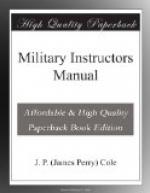(k) Rear Guards.—“A rear guard is a detachment detached to protect the main body from attack in the rear.” “The general formation is that of the advance guard reversed.” i.e. rear point, rear party, support, and main body. “In retreat a column is preceded by a body of troops designated ‘leading troops,’ whose principle duty is to clear the road of obstacles and to facilitate the withdrawal of the command.”
(l) Flank Guards.—As their name imply protect the flanks. They should be in constant communication with the column. Their formation usually conforms to that of patrols.
(m) Camps.—The four principal factors to be considered in the selection of the camp site are: near a good road or roads, have good drainage, plenty of room to accommodate your troops, and have a good water supply. Immediately after camp is made sinks are dug for the disposal of excreta. One should be dug for each company on the opposite flank from the kitchen for the disposal of human excreta, and one near the kitchen for the disposal of wastes, etc., that cannot be burned around the kitchen.
(n) March Outpost.—A march outpost is usually an advance guard halted, with observers in each unit on the alert. A cossack post might be established on a good near by observation point. The march outpost is the protection furnished the main body at short halts, or on making camp before the outpost is established.
(o) Outpost.—The outpost may be best illustrated by circles:
Each support is numbered from right to left. Each outguard in each support is numbered from right to left. Each sentinel post in each outguard is numbered from right to left. Outguards are divided into three classes, cossack posts, sentry squads and packets. A cossack post consists of 4 men, 1 posted in observation near the posts of the remaining three.
A sentry squad consists of one squad, posts a double sentinel post in observation near the post of the squad. A picket consists of two or more squads not exceeding half a company. It furnishes cossack posts, sentry squads, sentinel posts, and patrols. It is usually placed at the more important points of the outguard line, as a road fork, etc. The post furnished by pickets may be as far as 100 yards away. There should be also a sentinel post near the picket in observation. If the outguard consists of two or more companies there is a reserve. The reserve is held at some suitable point, where it can readily support the line. The reserve maintains connection with the main body and the support. The support occupies the line to be held. This line should be entrenched. The support maintains communication with its outguards and with each support on its flanks. It also sends out the necessary reconnoitering patrols. The outguards furnish sentinel posts and maintain communication with them, and with the outguards on each flank. It is the




